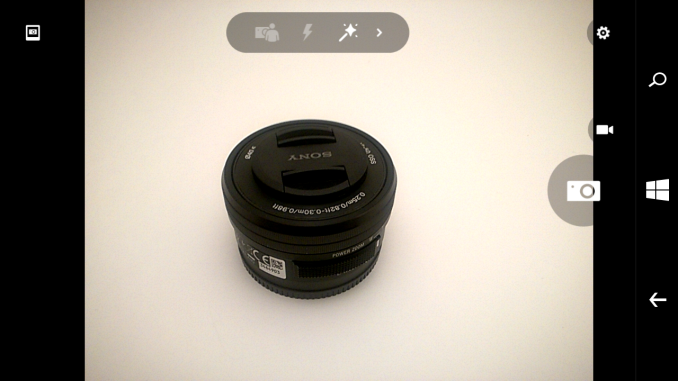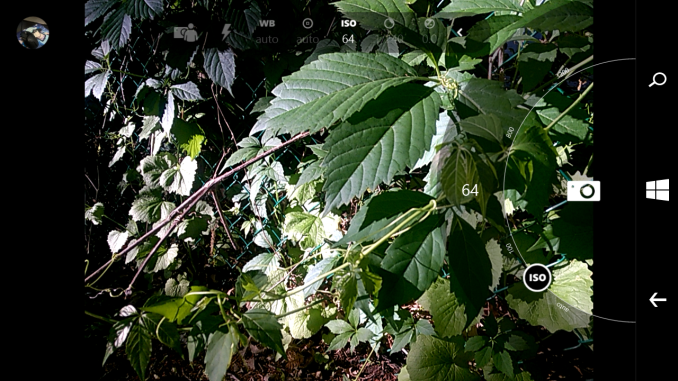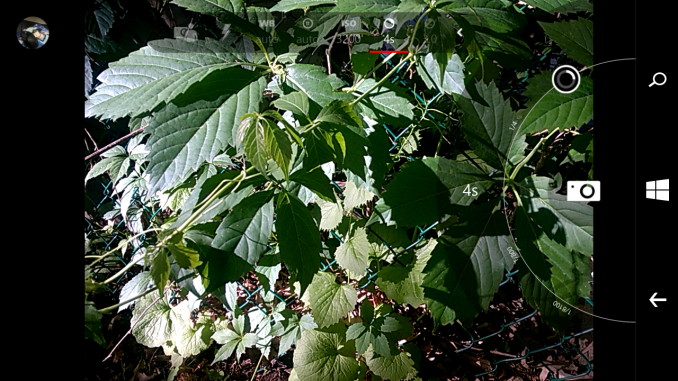The Microsoft Lumia 640 Review
by Brandon Chester on June 9, 2015 8:00 AM EST- Posted in
- Smartphones
- Microsoft
- Mobile
- Lumia
- windows phone 8
Camera Architecture
Due to the more closed nature of Windows Phone, I can’t do much poking around to find detailed information on the cameras in the Lumia 640. The information that I have been able to collect is organized in the chart below. The main omission is the sensor manufacturer, which I would suspect is Omnivison or Toshiba, but I can’t say for sure exactly what it is.
| Microsoft Lumia 640 Cameras | ||||
| Front Camera - Resolution | 0.9MP (1280x720) | |||
| Front Camera - Focal Length | 1.5mm (30mm eff) | |||
| Front Camera - Aperture | F/2.4 | |||
| Rear Camera - Resolution | 8MP (3264x2448) | |||
| Rear Camera - Sensor Size | 1/4", 1.12µm pixels | |||
| Rear Camera - Focal Length | 3.0mm (28mm eff) | |||
| Rear Camera - Aperture | F/2.0 | |||
On paper, the Lumia 640’s camera hardware is better than a lot of other devices at this price point. I recently reviewed the 2015 Moto E, and on paper the Lumia 640 has higher resolution cameras with larger sensors on the front and back, and the front camera has a significantly wider aperture. While the specifications of the camera sensor and lens aperture hardly tell the whole story when it comes to image quality, they definitely put the Lumia 640 in a better position when it comes to sharpness and low light performance.


The focus time on the Lumia 640 sits right in the middle of our comparison results. It’s slightly faster than many other devices that don’t have PDAF or laser based autofocus, but it’s not as fast as phones like the Nexus 6, and not near as fast as the iPhone 6 and Galaxy S6 with their PDAF. Shot latency is also right around the middle, and while there is a tiny bit of a delay between shots, I never felt like I was kept waiting for an unreasonable time when trying to take several photos quickly.
Camera UX
A device’s camera application has a big impact on the user’s experience when taking photos or shooting video. If the camera preview is cropped or badly scaled then it’s difficult for the user to gauge what their photos will look like. A high resolution preview and an accurate aspect ratio are necessary to frame and compose photos properly. For quite some time I’ve heard great praise for the Lumia camera application interface and the manual controls that it offers, so I was excited to have a chance to try it in depth.
Upon first opening the Lumia Camera app, I felt like the interface was fairly organized and well laid out. It was immediately obvious that tapping the right-facing arrow in the menu at the top would reveal more controls, and that hitting the gear in the upper right would show me options. Having a button to instantly record video is also very handy. The camera preview would definitely be improved if it were higher resolution, but this is mostly a limitation of the ISP so there's not much that can be done.
Once I started trying to use the manual controls I was very happy that the app uses what is basically a dial interface to make adjustments. It reminds me a lot of the control dials on a real camera, which is a good design decision, as anyone interested in these controls probably has prior experience with photography.
Unfortunately, I very quickly ran into a number of issues with the manual controls on the Lumia 640. The first problem was that I seemingly could only adjust one option at a time. While this is a common limitation of smartphone camera interfaces, it was very annoying because you had to continually move your thumb between the control wheel and the menu at the top. This is a much less ergonomic and more time consuming method of adjustment than something like ASUS’s camera interface where the menu for selecting each control and the menu for performing adjustments are beside each other.
After asking people who were more familiar with Windows Phone, I was told that you can pull outwards on the shutter button to bring up every control at once. I have two issues with this gesture. The first is that it’s not obvious at all. The only way I was able to find it was because I was told by another person, and that alone is a pretty massive design failure. My other issue is that it doesn’t directly solve my problem. I want the settings and the menu for adjusting them to be adjacent, not a giant menu of controls covering up the camera preview.
The fact that you wouldn’t be able to see the changes you’re making reflected in the preview because it’s covered by semi-opaque menus would be a big issue if it weren’t for an even bigger problem with the Lumia Camera application. The biggest issue of all is that camera preview does not change to reflect adjustments to ISO and shutter speed. At first, I had assumed my device was suffering from a bug, but after doing some troubleshooting I asked our editor Brett Howse to confirm that his Windows Phones behaved the same way. When he confirmed that they did I really didn’t know what to say. Having manual camera controls that aren’t reflected in the camera preview makes them essentially unusable. While changes to white balance, brightness, and focus do show up in the preview, your adjustments to ISO and shutter speed do not. This means that you have no visual idea of what the exposure of your photo is going to be.
I wasn’t near as impressed with the Lumia Camera application as I had expected to be based on what I had heard about how camera-centric Lumia devices are. While the interface for auto mode is fine, it’s basically impossible to mess that up unless you're trying to. The manual controls aren’t implemented in a very obvious and accessible manner, and the most important ones require you to just pray that the exposure meter is accurate, which ruins the entire concept of having full control over how your photos turn out.














130 Comments
View All Comments
testbug00 - Tuesday, June 9, 2015 - link
Just one FYI, Glance has multiple modes, including "peek" where it only activates when it detects something moving over it (or leaving a space where it always is 'sensing' something (IE, a pocket)And, yeah. Windows Phone uses a lot of battery life to have Wifi on. Dunno why. Even without any MS account on it and no non-native apps it still eats 2-2.5% of battery on 920. Haven't tested on other WP devices.
BrokenCrayons - Tuesday, June 9, 2015 - link
Nice phone for a good price, but it's positively huge with a 5 inch screen. Its disappointing that it's impossible to find a phone with decent specifications and a 3.5 inch screen. I can't imagine carrying this or any other phone that big around. I'd be tempted to tape a stick to it and use it as an oar.kyuu - Tuesday, June 9, 2015 - link
As someone whose smartphone history is iPhone 4, Lumia 920, and now Lumia 1520, I can tell you that once you've used a bigger smartphone (1520 has a 6" screen), you cannot go back to the small ones. They feel like toys and browsing the internet or watching videos on them is intolerable.Daniel Egger - Tuesday, June 9, 2015 - link
Get a 735 then. It's a very nice piece and noticeably smaller than the 640 plus it has an AMOLED display. It's a bit larger than my 820 which for me has about the perfect screen size but it's thinner and much lighter (especially since it has Qi built-in rather than needing a special cover which adds additional bulk and weight).MrSpadge - Tuesday, June 9, 2015 - link
Consider the Lumia 435 then. Internally it's not much different from the 640 if you can live with a few compromises.paulheu - Tuesday, June 9, 2015 - link
Google does not just not make any apps for Windows Phone, it actively blocks anyone else from doing the same if at all possible. Hopefully with Windows 10 this will change due to the very nature of that OS . We'll see..The remarks on Glance probably come from not having the extension app loaded which allows for backgrounds and more options.
Brandon Chester - Tuesday, June 9, 2015 - link
The Glance Screen app doesn't show up in the store for all Windows Phones, Lumia 640 included. If you look at the list of Microsoft apps when browsing the store on the phone it's just not even there.MATHEOS - Tuesday, June 9, 2015 - link
You definitely should have rating system!atata - Tuesday, June 9, 2015 - link
I've had this phone for several months and it feels great after Lumia 525. I certainly don't see the battery drain mentioned in this review, but I don't use most of fancy mobile apps aside from Viber.lilmoe - Tuesday, June 9, 2015 - link
"Microsoft's scroll speed cap also makes the entire operating system feel slow"This issue is so underrated, and I believe (even with your criticism) that you were very diplomatic in your complaint. This is BY FAR my biggest issue with Windows Phone and I've nagged Microsoft so many times on uservoice and the feedback app about the speed of scrolling and inertia settings (speed and feel of the "flick"). Not only does it feel slow, it's also not even close to being natural.
iOS is slower than my liking too, but it feels more natural in a sense. I believe Samsung got the speed and the "flick" right with their devices, and Android followed after JellyBean. Microsoft needs to blatantly copy Android in that department, and screw what people say.